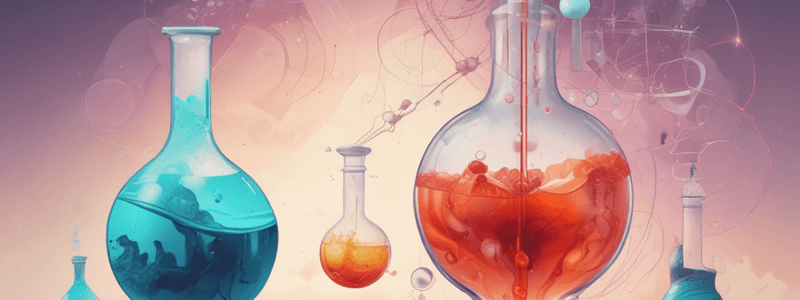Podcast
Questions and Answers
What is the direction of the equilibrium shift when the concentration of HI is increased?
What is the direction of the equilibrium shift when the concentration of HI is increased?
- Equilibrium remains unchanged
- Equilibrium moves to the right
- Equilibrium moves to the left (correct)
- Equilibrium is unaffected
What is the effect of a decrease in temperature on the equilibrium of the reaction H₂ + I₂ → 2HI?
What is the effect of a decrease in temperature on the equilibrium of the reaction H₂ + I₂ → 2HI?
- Equilibrium remains unchanged
- Reaction rate increases
- Equilibrium moves to the right (correct)
- Equilibrium moves to the left
What is the effect of adding a catalyst to a reaction that has already reached equilibrium?
What is the effect of adding a catalyst to a reaction that has already reached equilibrium?
- Equilibrium shifts to the right
- Equilibrium shifts to the left
- No effect on equilibrium (correct)
- Reaction rate increases
What is the direction of the equilibrium shift when the pressure is increased in a gaseous reaction?
What is the direction of the equilibrium shift when the pressure is increased in a gaseous reaction?
What happens to the equilibrium of a reaction when the concentration of H₂ is decreased?
What happens to the equilibrium of a reaction when the concentration of H₂ is decreased?
What is the effect of a temperature increase on the equilibrium of the reaction H₂ + I₂ → 2HI?
What is the effect of a temperature increase on the equilibrium of the reaction H₂ + I₂ → 2HI?
What is the direction of the equilibrium shift when the concentration of I₂ is decreased?
What is the direction of the equilibrium shift when the concentration of I₂ is decreased?
What happens to the equilibrium when the pressure is increased?
What happens to the equilibrium when the pressure is increased?
What is the optimal temperature used in the Haber process?
What is the optimal temperature used in the Haber process?
What is the purpose of a catalyst in the Haber process?
What is the purpose of a catalyst in the Haber process?
What happens to the equilibrium when the volume of the container is increased?
What happens to the equilibrium when the volume of the container is increased?
What is the effect of adding HCL to the solution in the experiment to illustrate Le Chatelier's Principle?
What is the effect of adding HCL to the solution in the experiment to illustrate Le Chatelier's Principle?
What happens to the colour of the solution when it is heated?
What happens to the colour of the solution when it is heated?
What is the effect of decreasing the pressure on the equilibrium?
What is the effect of decreasing the pressure on the equilibrium?
What is the purpose of the catalyst in the Haber process?
What is the purpose of the catalyst in the Haber process?
Study Notes
Le Chatelier's Principle
- Changes in concentration of one species:
- Increasing [H₂] moves the equilibrium to the right
- Increasing [HI] moves the equilibrium to the left
- Decreasing [I₂] moves the equilibrium to the left
Changes in Temperature
- If temperature is lowered, the system tries to increase temperature
- If temperature is raised, the system tries to lower temperature
- Exothermic reaction releases heat, equilibrium moves to the right
- Endothermic reaction absorbs heat, equilibrium moves to the left
Addition of a Catalyst
- A catalyst speeds up the reaction rate
- Adding a catalyst at the start of a reaction helps reach equilibrium quicker
- If added once equilibrium is reached, there is no effect on equilibrium
Changes in Pressure
- Increased pressure reduces the number of molecules in the container
- Decreased pressure increases the number of molecules in the container
- Example: If pressure increases, equilibrium moves to the right (4 molecules → 2 molecules)
- If pressure decreases, equilibrium moves to the left
- No effect if the number of molecules on either side of the equation is the same
Changes in Volume of a Container
- Increasing the volume means less pressure, equilibrium moves to the left
- Decreasing the volume means more pressure, equilibrium moves to the right
Industrial Applications
- Manufacture of ammonia by the Haber process
- Conditions: temperature (673K), pressure (200 atmospheres), catalyst
Experiment to Illustrate Le Chatelier's Principle
- Iron (III) chloride and potassium thiocyanate reaction
- Subjecting the reaction to concentration changes and temperature changes
- Concentration changes: adding HCL, potassium thiocyanate, or water
- Temperature changes: hot water or ice water
- Effects on the equilibrium reaction
Studying That Suits You
Use AI to generate personalized quizzes and flashcards to suit your learning preferences.
Description
Understanding Le Chatelier's Principle in chemistry, including how changes in concentration and temperature affect equilibrium. Learn how the system responds to changes in reactants and temperature.




